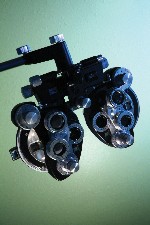During subjective refraction, we measure each eye individually as well as binocularly. Admittedly, autorefractors have advanced and now allow for fogging and unfogging each eye to achieve results similar to a subjective refraction. And, manufacturers have introduced programs to allow for binocular autorefraction, again offering results similar to the subjective refraction.
 |
With aberrometry, however, there are several concerns, namely:
The aberrometers currently available can measure only a single eye at a time.
The aberrometer sometimes keys in on a different retinal surface than the surface of the retina responsible for the subjective refraction. If the difference between these two surfaces was the same for every patient, then the difference could be easily compensated for. But, the surface on which the automated refraction is measured is not the same in all patients. Hence, there is no consistent offset or correction factor.
An aberrometer cannot compensate for the patients accommodative fluctuation during the measurement.
Researchers in Spain found that the accuracy of aberrometry is limited by noise and other sources of variability, including the size and alignment of the pupil.1
And, researchers at Indiana University found that increased variability in aberration maps between days and months indicates biological fluctuations that are large enough to prevent achievement of perfect vision, even if you can perfectly correct spherical and astigmatic refractive errors.2 However, they admit the lack of stability does not justify withholding treatment, and that there likely is a lasting benefit of aberration correction.
Larry N. Thibos, Ph.D., of Indiana University School of Optometry, says there are unresolved issues in the prediction of subjective refraction from wavefront aberration maps. These include the imprecise far point in human eyes and multiple strategies for locating an approximate far point.3
Until these issues are resolved, automated refractionincluding the use of an aberrometerwill remain an adjunct to the subjective refraction.
Visual Cortex
Keep in mind that the response offered by the patient during
subjective refraction is based on the visual cortex, the neural signal that translates the optical image. As optometrist Raymond Applegate points out, we are able to manipulate the optical side relatively easily, but manipulating the neural side is much tougher. (See The Reality of Super Vision, April 2005.) This represents another stumbling block to accepting aberrometry as a total replacement for subjective refraction.
Indeed, research has shown that visual perception is highly subjective and involves many aspects of image quality.4
Lost in Translation?
Besides the issues mentioned above, I believe that another concern about wavefront aberrometry exists. Specifically, the additional refractive data we gain does not easily translate into a refractive correction. Aside from customized LASIK and the Tecnis IOL (Advanced Medical Optics), which is based on wavefront technology, most forms of vision correction currently available do not offer specialized refractive correction to different parts of the pupil.
Of course, we know that technology will continue to advance, and eventually we will rely on the additional information supplied by the aberrometer to prescribe appropriate vision correction for our patients. For now, however, the aberrometer cannot duplicate the subjective refraction, nor does the additional data affect the vision correction we prescribe.
I believe it will take at least 10 or 15 years before these improvements are made. Then, perhaps, wavefront aberrometry may replace subjective refraction.
Perhaps one day, researchers will even incorporate electrodiagnostic techniques into aberrometry, which will allow O.D.s to assess the cortical response, thus fine-tuning the aberrometers data. That would be the ultimate form of refractionone that I dont anticipate happening for at least 50 years.
Dr. Benjamin is a professor of optometry and vision science at the University of AlabamaBirmingham School of Optometry and is editor of Boorishs Clinical Refraction (W.B. Saunders, 1998).
1. Rodriguez P, Navarro R, Gonzalez L, Hernandez JL. Accuracy and reproducibility of Zywave, Tracey, and experimental aberrometers. J Refract Surg 2004 Nov-Dec;20(6):810-7.
2. Cheng X, Himebaugh NL, Kollbaum PS, et al. Test-retest reliability of clinical Shack-Hartmann measurements. Invest Ophthalmol Vis Sci 2004 Jan;45(1):351-60.
3. Thibos LN. Unresolved issues in the prediction of subjective refraction from wavefront aberration maps. J Refract Surg 2004 Sep-Oct;20(5):S533-6.
4. Cheng X, Thibos LN, Bradley A. Estimating visual quality from wavefront aberration measurements. J Refract Surg 2003 Sep-Oct;19(5):S579-84.

